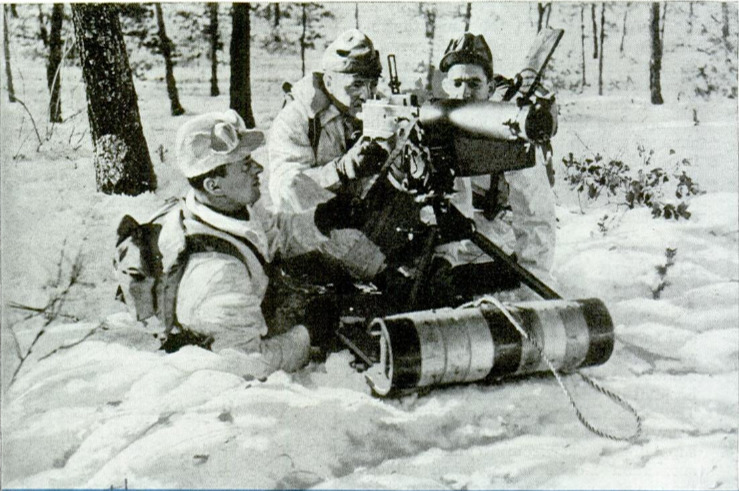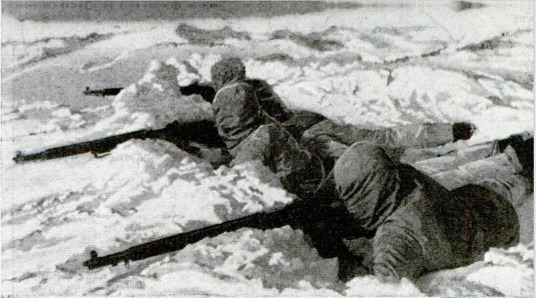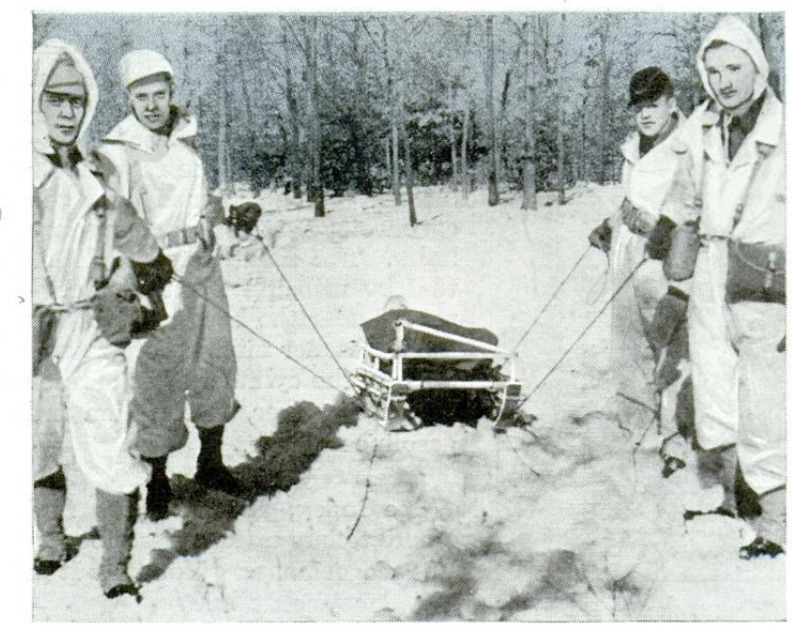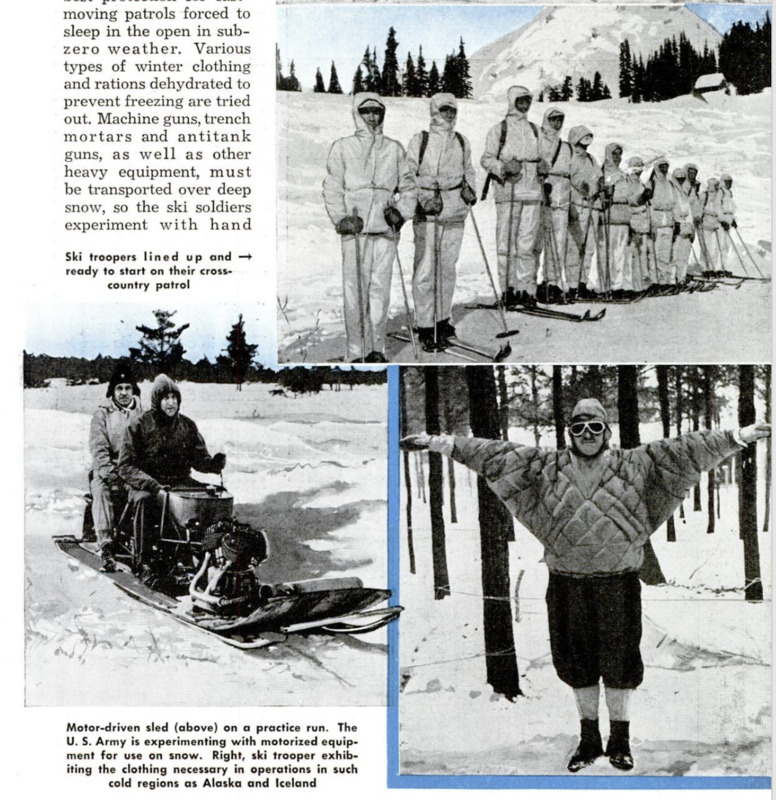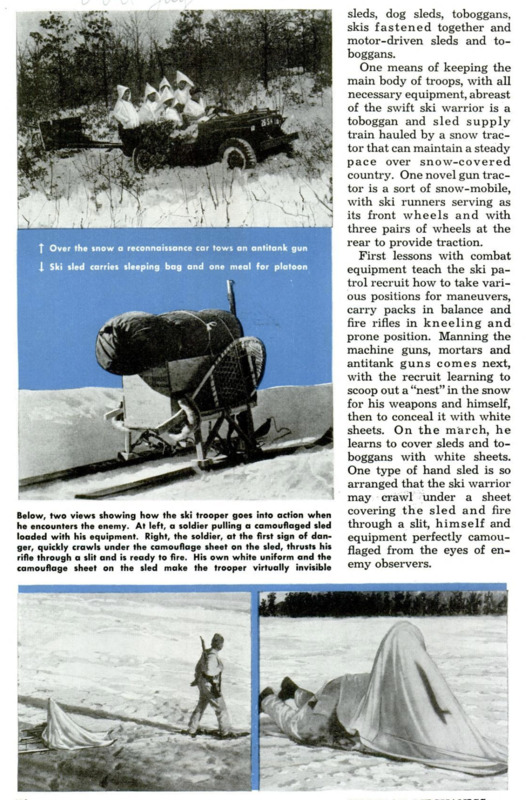FLITTING like ghosts across the snow, whole battalions of the United States Army are mastering the art that enabled ski-shod Finnish soldiers to combat superior Russian forces in the bitter cold of their northern Europe battleground. A trained skier is at least four times as useful as the man floundering afoot throughsnow and icy crust. That is the lesson taught by the Finnish campaign and the lesson that our army is putting to good use. Almost invisible in his white camouflage suit, the ski warrior moves swiftly to strike the enemy at vulnerable points and to gather information of the enemy’s movements. Technically, his is the role of a fighting scout for the main body of troops. Parkas of colors to blend with the winterscene, skis of different lengths and poles made of metals and woods are being tested by the army in development of its fighting units on skis. Small shelter tents and sleeping bags are being used together to determine the best protection for fast-moving patrols forced to sleep in the open in subzero weather. Various types of winter clothing and rations dehydrated to prevent freezing are tried out, Machine guns, trench mortars and antitank guns, as well as other heavy equipment, must be transported over deep snow, so the ski soldiers experiment with handsleds, dog sleds, toboggans, skis fastened together and motor-driven sleds and toboggans. One means of keeping the main body of troops, with all necessary equipment, abreast of the swift ski warrior is a toboggan and sled supply train hauled by a snow tractor that can maintain a steady pace over snow-covered country. One novel gun tractor is a sort of snow-mobile, with ski runners serving as its front wheels and with three pairs of wheels at the rear to provide traction. First lessons with combat equipment teach the ski patrol recruit how to take various positions for maneuvers, carry packs in balance and fire rifles in kneeling and prone position. Manning the machine guns, mortars and antitank guns comes next, with the recruit learning to scoop out a “nest” in the snow for his weapons and himself, then to conceal it with white sheets. On the march, he learns to cover sleds and toboggans with white sheets. One type of hand sled is so arranged that the ski warrior may crawl under a sheet covering the sled and fire through a slit, himself and equipment perfectly camouflaged from the eyes of enemy observers. Snow tricks reminiscent of pioneer warfare are taught the ski soldier. If there is danger of being observed from an elevation, he and other members of his patrol are cautioned to move in single file, thus leaving only one track in the snow. The recruit learns to loosen his skis in order to fire in various positions, yet must keep them on to be in readiness for quick advances or shifts in position. Most of the men in training never have worn skis before, yet their progress is far more rapid than that of the average skier. They master the principles of balance in three or four days, quickly getting the feel of the skis and then going on to the fundamentals of walking, “running,” “kickturns” and such climbing steps as the “her-ring-bone.” Tricks of balance are acquired through use of the ski poles and in a few weeks’ time, as their skill increases, the men are taught the advanced technique of controlled “stem turns” and “christies” with packs and rifles in addition to their skiing equipment. In ski patrol tactics, the rifle is hung over the back instead of being slung, thus keeping the weapon free from snow in case of spills. Basic essentials for the ski soldier, in addition to his skis and rifle, are a pair of poles, a pair of ski boots, a pair of water-repellent ski trousers, two pairs of heavy socks, one parka, one cap, goggles, gloves and first-aid kit. The ski patrol is far from being a “soft” part of the army, in spite of the fascination of skiing. The men must have the skill and grace of athletes, the courage of lion tamers and a generally rugged physique. Skiing is difficult and tiring enough when all you have to do is ski. Add to that the heavy equipment necessary to the ski soldier and you can understand why no electric lights are necessary in some of the training camps - the men are too tired at the end of the day to remain awake. Sleeping in the open in sub-zero weather is serious business, too. To prevent the men from freezing to death, guards are assigned to make frequent rounds among their sleeping fellows, a precaution common in the Finnish army. Large scale training got under way last winter for the first time in this country with picked units of the First, Third, Fifth and Sixth Divisions of the regular army and the Forty-first and Forty-fourth divisions of the National Guard stationed in the 15 states that comprise the snow belt. Units at Fort Custer, Michigan, Fort Lewis, Washington, and Fort Devens, Massachusetts, were among those singled out for preliminary training in winter campaigns. Fort Snelling, Minnesota, already had several hundred ski troopers. The War Department approved a program volunteered by the National Ski Patrol Service to direct civilian activities and provide the corps of technical consultants for regional army commanders. Composed of 2,000 experienced skiers, the organization already had zoned the snow belt for its 89 local patrols as the first step toward gearing a civilian organization to army requirements. In this organization, winter sportsmen rehearsed their part as civilian scouts, the first this country has known since the Indian Wars. And how does the American soldier like maneuvers on skis? One instructor says that his morale is comparable to that of a baby with a new toy. Mastering the snowshoe also is taught the snow-going soldier. Generally regarded as much slower than the ski, the snow-shoe attained new importance as the result of a cross-country race through the Wisconsin wilds last winter. Covering a sevenmile course through difficult country, one soldier crossed the finish line in 4.5 minutes, while the fastest time on skis was 41.7 minutes. However, the relative proportion of skis and snowshoes used by the armywill be determined by snow conditions, type of terrain, nature and quantity of undergrowth, degree of efficiency of the men and the mission to be performed. In the Wisconsin race, conditions favored the snowshoer. Both ski and snowshoe have advantages for different types of snow. Defense of the northern borders of the United States under severe winter conditions is the purpose of the training program, but the ski trooper also will be quite useful in such advanced posts as Alaska and Iceland. Several thousand pairs of snowshoes, plus a quantity of packboards and down-filled sleeping bags have been sent to Alaska alone and quantities of similar equipment to Iceland. The packboards may be mounted easily on a pair of skis to form hand sleds for carrying equipment. The men in Alaska are based mainly at Chilkoot Barracks, Fairbanks, and Anchorage. Itis understood that in Alaska the accent is on snowshoes rather than skis because the soldiers can be trained to use the shoes more quickly. At Fort Dix, N. J., white parka-clad troops participated in an impressive maneuver demonstrating to some extent the value of the ski soldier in winter warfare. One detachment took up positions in a snow-covered field along the Lewistown-Juliustown road. Officers reported the men blended completely with the snow at 500 to 600 yards and were invisible from the road which they could cover with rifle fire. Discarding the parkas the men spaced out like fence posts in a maneuver to deceive the enemy into believing the detachment was a fence. The effect was startling, | and realistic. During these winter maneuvers, the men in their white clothing take advantage of natural cover as they move through all types of terrain, receiving instruction constantly in offensive practice maneuvers against a snowshoe platoon, designated as the enemy barrier through which ski scouts attempt to slip during night and day sallies. Although service with a ski patrol isn't “soft,” like many other pursuits in which there are elements both of skill and hazard, it attracts large numbers of young men. Many recruits have requested northern post assignments simply because they “want to ski.”
